
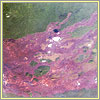

|
|
1. Lava Flow
Lava flows are masses of magma that pour onto the Earth's surface during an eruption; they include both moving lava and the resulting solidified deposits of black rock. Lava flows come in a great variety of shapes and sizes. Nyiragongo is considered one of the most dangerous volcanoes in the world because of its particularly fast-moving lava, which can flow more than 60 miles per hour. During the 2002 eruption, swaths of lava up to 165 feet wide tore down Nyiragongo's slopes, burning everything in their path.
|
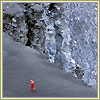

|
|
2. Tephra
Tephra is a general term for fragments of volcanic rock and lava that are blasted into the air by explosions or carried upward by hot gases. Tephra includes large, dense chunks, light rock debris, and ash. The restless lava lake in Nyiragongo's summit crater regularly causes eruptions of gas and smoke laden with tephra.
|
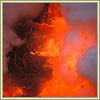

|
|
3. Lava
Lava is the word for magma when it erupts onto the Earth's surface. Geologists also use the term to describe the solidified deposits of lava flows. Lava is from the Italian word for stream, which is derived from the verb lavare, to wash. The type of lava erupted by Nyiragongo and many volcanoes in the East Rift zone of Africa, called alkaline lava, has an extremely low viscosity, making it almost as fluid as water. Alkaline lava has a melting temperature in excess of 2,000 degrees Fahrenheit. The fluidity and extreme temperature of Nyiragongo's lava make for a particularly deadly combination during eruptions.
|
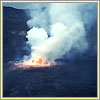

|
|
4. Crater and Lava Lake
Nyiragongo's most unique feature is its enormous summit crater. It is 2,600 feet deep, or nearly half a mile. As seismic activity within the volcano increases, the crater periodically contains an active lava lake that can drain suddenly and catastrophically out of Nyiragongo, gorging the volcano's fissures with spewing fountains of fast-moving lava. This occurred during Nyiragongo's lethal eruptions in 1977 and 2002, wreaking havoc on the city of Goma and its people. In November 2002, ten months after the latest eruption, a new lava lake appeared at the bottom of the crater. It is still active today, and experts are trying their best to predict when it will erupt and drain from Nyiragongo again.
|
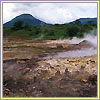

|
|
5. Vent
Vents are openings in the Earth's crust from which magma and volcanic gases escape onto the ground or into the atmosphere. Vents may consist of a single, circular-shaped structure, a large elongated fissure or fracture (as seen on the diagram above) or a tiny ground crack. Nyiragongo is notorious for releasing large amounts of sulfur dioxide through its many vents. At up to 50,000 tons each day, this is more than any other active volcano, and it presents a serious health hazard to people and animals living in close proximity.
|
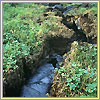

|
|
6. Fissure
On volcanoes, a fissure is an elongated fracture or crack at the surface from which lava erupts. Fissure eruptions typically dwindle to those at a central vent after a period of hours or days. Nyiragongo has a complex system of fissures, which extend from its summit crater all the way down to the city of Goma on its lower flanks. Lava can burst out of these fissures without warning, as occurred in 2002 at the edge of the city, killing more than 100 people, leaving over 120,000 homeless, and destroying 40 percent of the city. Scientists believe a fissure could open directly underneath Goma in a future eruption, precipitating a catastrophe.
|
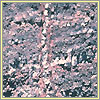

|
|
7. Dike
Dikes are tabular or sheet-like bodies of magma that cut through and across the layering of adjacent rocks and then solidify. They form when magma rises into a fissure or creates a new crack by forcing its way through rock. Hundreds of dikes can invade the cone and inner core of a volcano, as they do in Nyiragongo, often along zones of structural weakness.
|
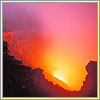

|
|
8. Magma
Magma is molten or partially molten rock beneath the Earth's surface. When magma erupts onto the surface, it is called lava. Magma typically consists of a liquid portion, often referred to as the melt; a solid portion made of minerals that crystallized directly from the melt; solid rocks incorporated into the magma from along the conduit or reservoir; and dissolved gases. Magma collects inside a volcano's magma chamber before it erupts. Nyiragongo's magma chamber is located about 10 miles below the surface of the Earth.
|

| 
|


